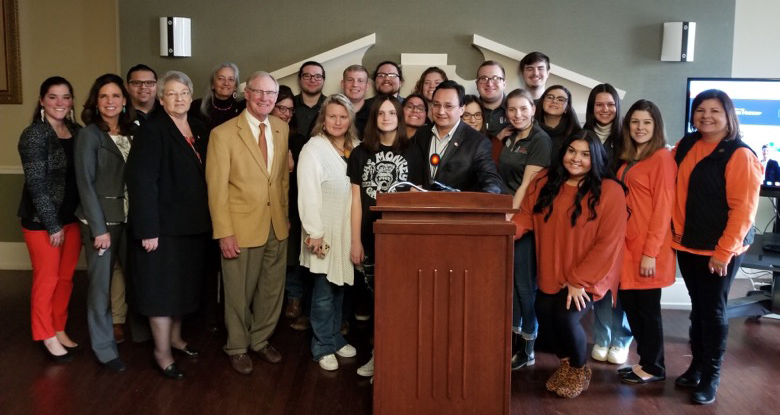
Cherokee Nation chief speaks on tribal history at OSU
Monday, February 3, 2020
The leader of the Cherokee Nation — with more than 380,000 tribal citizens worldwide including over 141,000 in northeastern Oklahoma — recently spoke about its storied history during a Sovereignty Speaks speakers series luncheon at the Oklahoma State University Student Union.
Principal Chief Chuck Hoskin Jr. shared the history of the Cherokee Nation from the past 200 years.
“We are in an era of prosperity the likes of which we have not seen,” Hoskin told the crowd after he was welcomed by OSU President Burns Hargis.
He credits much of that to a change in federal law in the 1970s that “allowed us to reconstitute and rebuild,” and the Indian Gaming Regulatory Act, which allowed Cherokee and other tribal nations to operate Las Vegas-style gaming.
Hoskin called the gaming compact the most successful state-tribal partnership in history, bringing in $1.5 billion for Oklahoma in the past 15 years.
Another highlight for the Cherokee Nation is the partnership with OSU that’s building the first tribally affiliated medical school in the country — OSU College of Osteopathic Medicine at the Cherokee Nation — in Tahlequah, Oklahoma. A new $40 million facility is currently under construction.
But while things are going well now for the Cherokee Nation, Hoskin wants to make sure people don’t forget the past.
Hoskin, who was elected principal chief in 2019, described his people’s story as involving dispossession and travesties of justice — and responses of grit, determination and strength.
The Cherokee people were living in the southeastern United States in and around Georgia.
“As the U.S. was growing around the Cherokee Nation … we changed how we governed ourselves,” Hoskin said. “We developed a written constitution. We elected a chief. We centralized in strength and our government so we could deal with what was happening around us.”
President Andrew Jackson signed the Indian Removal Act into law in 1830, forcing tribes from their lands in what has become known as the Trail of Tears.
Hoskin said the Cherokee started the Cherokee Phoenix newspaper to share stories of injustice while holding out and resisting as long as possible.
Members of the Cherokee Nation were rounded up in stockades and marched across the country. Hoskin said that one-quarter of the Cherokee Nation’s people died heading to what is now northeast Oklahoma.

“We were torn apart politically; our economy was destroyed,” Hoskin said. “You would predict it would take decades or generations to come back if they ever did. But what happened next is I think is one of the most remarkable stories in the history … of this country and the world. We rebuilt within about a decade. We invested in a system of law and justice. … democracy and education.”
Nearly 200 years has passed but, “We have to remember, and we have to remind people … what the Indian nations have gone through,” Hoskin said.
The Sovereignty Speaks program was presented by OSU’s Center for Sovereign Nations, which was created in 2015 and works to promote Native American student success and greater understanding of tribal sovereignty, while increasing the number of quality partnership projects between the university and Oklahoma’s 39 tribal nations.
“I appreciate that OSU established the Center for Sovereign Nations. … I think this says so much about this school,” Hoskin said.
MEDIA CONTACT: Monica Roberts | Director of Media Relations | 405-744-4800 | monica.roberts@okstate.edu
